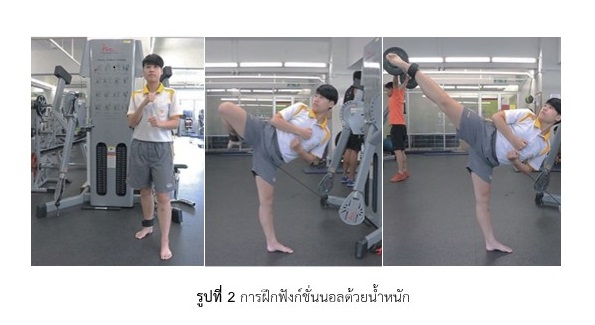EFFECTS OF PNEUMATIC FUNCTIONAL TRAINING ON THE ROUNDHOUSE KICK VELOCITY TO THE HEAD IN MALE TAEKWONDO ATHLETES
Main Article Content
Abstract
Purpose: The purpose of this study was to investigate effects of pneumatic of functional training on the roundhouse kick velocity to the head and to compare with weight of functional training on the roundhouse kick velocity to the head in male taekwondo athletes.
Methods: Twenty male taekwondo athletes from University, aged range between 18-22 years, were recruited. They were divided into two groups, 1) pneumatic functional training group (n=10) and 2) functional training group (n=10) Both groups were trained at 40% 1RM 3 days per week for 6 weeks. The dependent variables include kicking velocity: Hip angular velocity, knee angular velocity, knee velocity and foot velocity. The obtained data were analyzed in term of means and standard deviations and verified by comparing t-test with a technique of pair sampling t-test and independent t-test, respectively. Differences were considered to be significant at p < .05.
Results: The mean values of kicking velocity: Hip angular velocity, knee angular velocity, knee velocity and foot velocity in the pneumatic of functional training group was significantly higher than pre-test at the .05 level and no significant different in
the mean values of kicking velocity in the weight of functional training group among post-test
Conclusion: The pneumatic of functional training group had positive effects on the roundhouse kick velocity to the head and can be used training for taekwondo athletes.
Article Details

This work is licensed under a Creative Commons Attribution-NonCommercial-NoDerivatives 4.0 International License.
References
Abernethy, B., Kippers, V., Hanrahan, S. J., Pandy, M. G., McManus, A. M., and Mackinnon, L. (2013). Biophysical Foundations of Human Movement (Third edition.) Champaign, IL.: Human Kinetics.
Bompa, T. O. (1999a). Periodization training for sport: Agility and strength training. Toronto, Canada: Veritas.
Bompa, T. O., and Carrera, M (2005). Periodization training for sport (second edition.) Champaign, IL: Human kinetics.
Bloomfield, j., Ackland, T. R., and Elliott, B. C. (1994). Applied anatomy and biomechanics in sport. Melbourne: Blackwell Scientific Publications.
Department of Physical Education. (2016). Taekwondo sports trainer training manual according to the professional standard course, Taekwondo sports trainer. (Online). Retrieved June 16,2018, from Department of Physical Education Website: https://www.dpe.go.th/manual-files-392891791927
Dokchan, V. (2012). A Comparison of two different resistance training on velocity and force of axe kick in female taekwondo athletes. Master’s Thesis, Faculty of Sport Science, Chulalongkorn University.Bangkok.
Estevan, I., Alvarez, O., Falco, C., Garcia, M. J., and Castillo, I. (2011). Impact force and time analysis in fluenced by execution distance in a roundhouse kick to the head in Taekwondo. Journal of Strength and Conditioning Research, 25(10), 2851-2856.
Estevan, I., Falco, C., Alvarez, O., and Garcia, M. J. (2012). Effect of Olympic Weight Category on Performance in the Roundhouse Kick to the Head in Taekwondo. Journal of Human Kinetics, 31, 37-43.
Estevan, I., Jandacka, D., and Falco, C. (2013). Effect of stance position on kick performance in Taekwondo. Journal of Sports Sciences, 31(16), 1815–1822.
Estevan, I., Falco, C., Silvernail, F. J., and Jandacka, D. (2015). Comparison of Lower Limb Segments Kinematics in a Taekwondo Kick. An Approach to the Proximal to Distal Motion. Journal of Human Kinetics volume, 47, 41-49.
Fong, S.S.M. and Tsang, W.W.N. (2012) Relationship between the duration of Taekwondo training and lower limb muscle strength in adolescents. Hong Kong Physiotherapy Journal, 30, 25-28.
Frost, D. M., Cronin, J. B., & Newton, R. U. (2008). A comparison of the kinematics, kinetics and muscle activity between pneumatic and free weight resistance. European journal of applied physiology, 104(6), 937–956.
Frost, D. M., Cronin, J., and Newton, R. U. (2010). A biomechanical evaluation of resistance: fundamental concepts for training and sports performance. Sports Medicine, 40(4), 303-326.
Ha, C. S., Choi, M. H., and Kim, B. Y. (2009). The kinematical analysis of the Taekwondo sparring players Bandal Chagi in kinematics. International Journal of Applied Sports Sciences, 21(1), 115-131.
Kazemi, M., Waalen, J., Morgan, C., & White, A. R. (2006). A profile of olympic taekwondo competitors. Journal of sports science & medicine, 5(CSSI), 114–121.
Keiser Corporation. (2011). When is a pound not a pond? Keiser compares iron and air. (Online).Retrieved September 11,2018, from Keiser Corporation [US] Website: http://www.keiser.com/media/pound.pdf
Kim, Y. K., Kim, Y. H., & Im, S. J. (2011). Inter-joint coordination in producing kicking velocity of taekwondo kicks. Journal of sports science & medicine, 10(1), 31–38.
Kukkiwon. (2013). Foreigner Instructors course text book. Seoul.
La-Bantao, K. (2011). A comparison of training effects between different proportion of combined of pneumatic and free weight resistance on muscular strength and power. Master’s Thesis, Faculty of Sport Science, Chulalongkorn University. Bangkok.
Lawton, T. W., Cronin, J. B., & Lindsell, R. P. (2006). Effect of interrepetition rest intervals on weight training repetition power output. Journal of strength and conditioning research, 20(1), 172-176.
Makaya, I. (2007). Martial arts conditioning: Elastic resistance band training. Martial arts Illustrated magazine. [Online]. Available from: http://www.martialartsunltd.co.uk.
Patterson, R. M., Stegink Jansen, C. W., Hogan, H. A., & Nassif, M. D. (2001). Material properties of Thera-Band Tubing. Physical therapy, 81(8), 1437-1445.
Peltonen, H., Häkkinen, K., & Avela, J. (2013). Neuromuscular responses to different resistance loading protocols using pneumatic and weight stack devices. Journal of electromyography and kinesiology, 23(1), 118-124.
Pantong, S. (2017). Effects of attack lunge training with pneumatic resistance on lunge performance in fencers. Master’s Thesis, Faculty of Sport Science, Chulalongkorn University. Bangkok.


